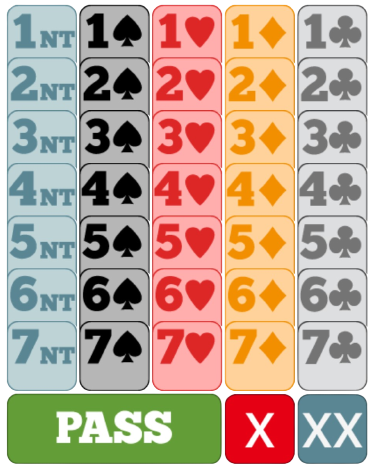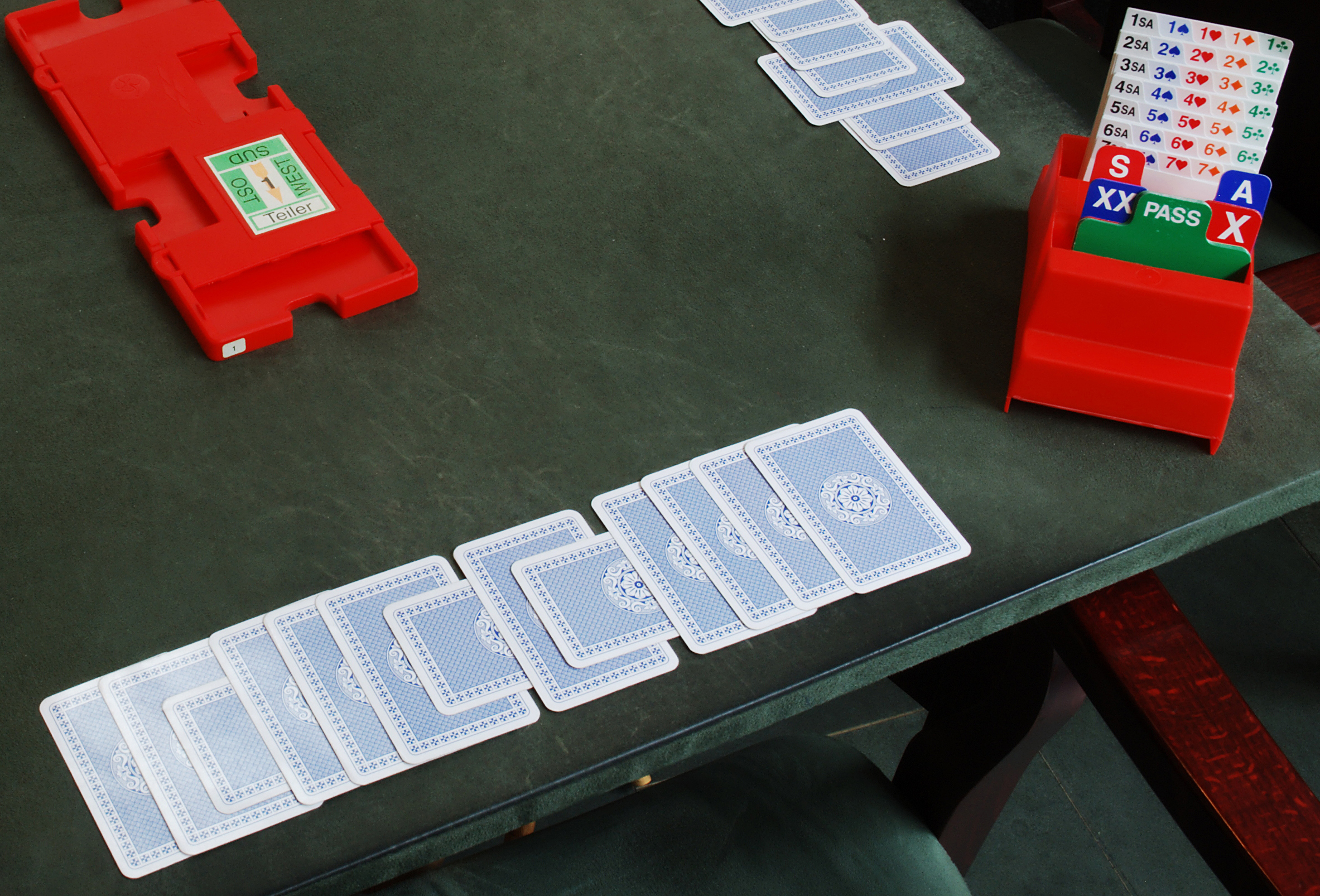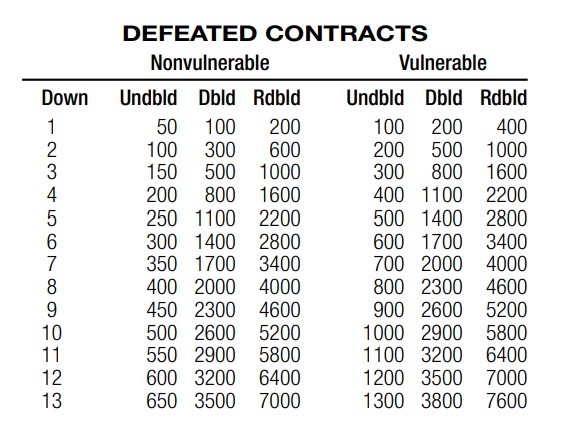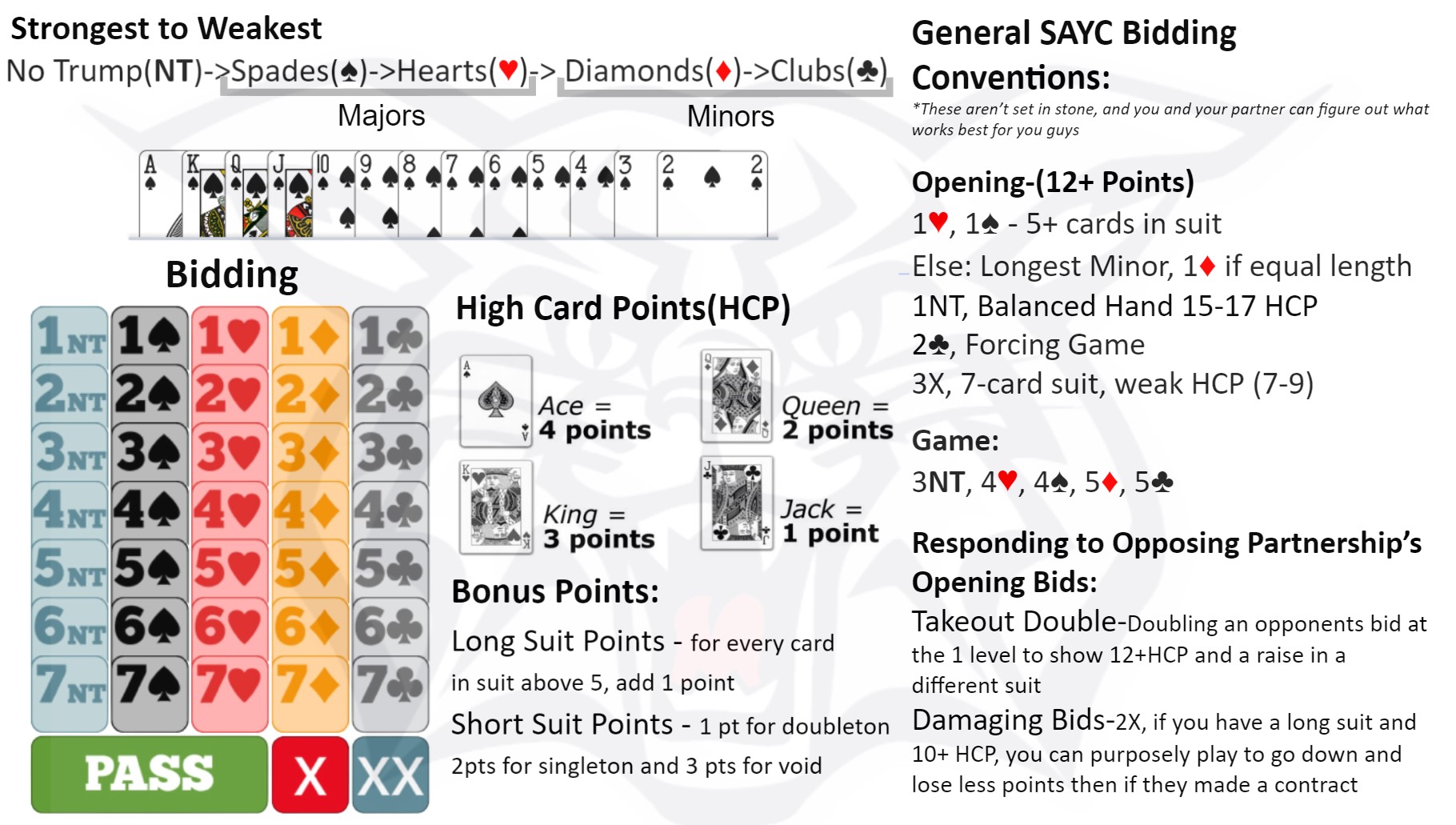Getting Started
This is a tutorial on how to get started playing bridge on a casual level. We recommend that you start by learning to play, then bidding, and finally if you are really up for it scoring. Scoring is complex and the rules for it change between different variants of bridge, so the best way to start out with scoring is to use a scoring cheatsheet, like this one from ACBL(American Contract Bridge League): https://web2.acbl.org/documentLibrary/play/InstantScorer.pdf.
Materials
- 4 Players
- Standard 52 Deck of Playing Cards
- Paper and Pencil(for scoring)
Bridge is a card game played with 4 players divided into 2 teams of 2 called pairs/partners. Each side of the table is marked by North, East, South, or West. Players in a partnership sit across from each other in North-South and East-West teams. The game consists of 2 main parts: bidding and card play described below.
Generally, the game starts with whoever is sitting in the North end and they will shuffle and deal the deck of cards equally among the 4 players(13 cards each). After dealing out the cards, the dealer will begin the first phase of the game: bidding. The dealer rotates 1 player clockwise between deals. Each full round of play after dealing, bidding, and playing all the cards is called a deal. The playing phase of the deal consists of 13 tricks which represent the 13 rounds of card play where each person plays a card on their turn.
One recommendation is that it may generally be easier to learn how the playing phase of Bridge works before going back and learning the bidding phase.
Part 1: Bidding
The goal of the bidding phase is to nominate a contract that the team who called the bid will play. During the entire bidding phase of the game, partners and opposing teams are not allowed to communicate through any means verbally or nonverbally other than through their bids.
A contract consists of the 2 parts a number 1 through 7 and a trump suit.
- The number represents the number of tricks plus six(because 13/2 rounds down to 6) that the bidder thinks they and their partner can win.
- The suit bid can be clubs(♣️), diamonds(♦️), hearts(♥️), spades(♠️), or no trump(NT). The suit bid will be the trump suit which will make it better than other suits during the playing phase. No trump means that there are no trump suits.
Winning Bid
Bidding starts from the dealer, who makes the first bid and subsequent bids are made in clockwise order until 3 passes in a row from the other players, meaning they don’t want to bid higher. When a team wins a contract, the player on the team who first bid the suit in the final contract is considered to have won the bid(this is important for who begins play). For example, if North starts with 1♠️, and the contract ends with South who bid 4♠️, even though in that partnership South had the last bid, North is considered the winner of the bid. The winner of the bid is also called the declarer.
Bid Strength
- The higher the number of tricks, the higher the bid
- When bidding to win the same number of tricks, the suit strength from weakest to strongest is as follows: Clubs(♣️), Diamonds(♦️), Hearts(♥️), Spades(♠️), No Trump(NT)
 Generally in Bridge, bidding the highest and most precise contract a team can win will award that partnership the most points. If a player thinks that the opposing team has bid an unmakably high contract they can bid a double, this will be counted as another bid and will require another 3 passes to end the bidding. A double will double the number of points won or lost by the declaring team. In rare cases, if the bidding team is confident that they can make the contract they can redouble the contract, therefore quadrupling the number of points won or lost.
Generally in Bridge, bidding the highest and most precise contract a team can win will award that partnership the most points. If a player thinks that the opposing team has bid an unmakably high contract they can bid a double, this will be counted as another bid and will require another 3 passes to end the bidding. A double will double the number of points won or lost by the declaring team. In rare cases, if the bidding team is confident that they can make the contract they can redouble the contract, therefore quadrupling the number of points won or lost.
Biding is a complex process when you must guess with only knowledge of your cards and everybody’s bids what everybody’s hands(a hand is all the cards that have been dealt to you) look like. For more information look at bidding systems in resources.
Part 2: Playing
After a contract is decided upon, play starts with the player sitting one spot clockwise of the declarer. For instance, if North wins the bid then East begins play.
The first card played is called “opening lead” and is conventionally played faced down.
In bridge the partner of the declarer is called the “dummy” which stands for silent in French. The dummy will place their hand face up on the table for everyone to see and every card the dummy plays will be decided by the declarer.
The play will continue in a clockwise order with each person playing a card that matches the suit of the first card played if they have a card in that suit. Card strength from weakest to strongest in the same suit is 2,3,4,5,6,7,8,9,10,J,Q,K,A
Trumping/Ruffing
If a suit is played and a player does not have a card in that suit, then the player could play any card in his hand. Usually, if they play a card of a different suit, that card will be thrown, however, if the card played is of the trump suit, then this is called a ruff and a card in the trump suit will be stronger than a card in any other suit.
End of deal
It is conventional that at the end of each trick, cards will be flipped over in a pile in front of each player and faced toward the partnership that won. for example, if the North-South partnership won it will be faced as seen in the diagram:

This will make counting tricks easy at the end, and if the players want to review what they played, they can flip over the cards and see the play in order. At the end of the deal, the number of tricks won by the declaring side is counted and points will be calculated.
Scoring
Special thanks to FunBridge for providing a detailed version of the scoring. The specifics of scoring and vulnerability are hard, for getting started we recommend just understanding the Game and Slam bonuses and using a points card scoresheet, an online point calculator can be found here: https://www.funbridge.com/counting-bridge
Vulnerability
In rubber bridge, a side becomes “vulnerable” when it has already won one game and is thus subject to doubled penalties. When you are vulnerable, premiums and penalties are much higher. The other side is “non-vulnerable”.
In contract bridge, which is the modern variant of bridge, the vulnerability of each side varies from one deal to another based on the number of deals. Vulnerability aims at diversifying opposition situations and making the game more interesting.
The different combinations of vulnerability (love all, game all, unfavorable, favorable) are rotated. When you are vulnerable, you are said to be “red”. When you are not vulnerable, you are said to be “white”.
Trick Points
These points are allocated for the tricks taken in a successful contract only. Overtricks are counted separately.
If the declarer makes his contract, the number of tricks taken (over “book”, i.e. over trick 6) is counted and multiplied by the contract suit factor. Points for each trick required and taken are scored as follows: 20 points in clubs and diamonds, 30 points in hearts and spades, 40 points for trick 7 in notrump, and 30 points per trick over trick 7.
These points are multiplied by two or quadrupled respectively if the contract has been doubled or redoubled.
Bonuses
The most important part of scoring to know is understanding the bonuses(especially game and slam), these incentivize players to more accurately bid their hands, rather than always playing safe and underbidding.
Part-score Bonus
Part-score bonus is where the final contract by tricks would normally score less than 100 points, in this case, a 50-point bonus is awarded for making a small contract. For example, making a contract in 1♣️ would only grant 20 points according to trick points, however, after the part-score bonus there will be a 70-point total.
Overtrick Bonus
Overtricks are the extra tricks made in surplus of the required amount for the contracts, these tricks will only add 20 or 30 points to the final score.
Game Bonus
The game bonus is added when the final contract by tricks scores 100 or more points, then the non-vulnerable side receives a 300-point bonus and the vulnerable side receives a 500-point bonus instead of a part-score bonus.
Slam Bonus
- Small Slam: Grand slam is when 12(all but 1) tricks are taken and a 500 or 750 point bonus is applied, based on non-vulnerable and vulnerable respectively.
- Grand Slam: Grand slam is when all 13 tricks are taken and a 1000 or 1500 point bonus is applied, based on non-vulnerable and vulnerable respectively.
Doubling and Redoubling
These will apply a weighted point bonus to the trick points if the declaring team makes the contract and if they fail it will apply a heavy penalty to the final points.
Undertricks and Penalties
If the declaring team fails to make the number of tricks they nominated in their bid, then the contract fails, and for each extra trick below the nominated number of tricks, penalty points will be awarded to the opposing team. This can be seen in the undertrick section of the score sheet:

Bridge Scoresheet
Access and print the scoring cheatsheet from ACBL: https://web2.acbl.org/documentLibrary/play/InstantScorer.pdf
Bridge CheatSheet
This is a cheatsheet we created for those learning Bridge:
 The pdf is linked here: https://westviewbridgeclub.online/uploads/westview-bridge-cheat-sheet-v2.pdf
The pdf is linked here: https://westviewbridgeclub.online/uploads/westview-bridge-cheat-sheet-v2.pdf
Playing Materials and Learning Resources
- FunBridge Scoring tool
- Play Bridge Online Immediately
- Funbridge Learn
- FunBridge Practice
- BridgeBase Practice
Article Resources:
Below are a few resources used for research to ensure information was accurate:
- https://www.funbridge.com/how-to-play-bridge
- https://www.youtube.com/watch?v=Arq3t0iHfPE&t=6s
- https://www.funbridge.com/counting-bridge
- https://en.wikipedia.org/wiki/Contract_bridge
- Bridge Scorecard Image: https://web2.acbl.org/documentLibrary/play/InstantScorer.pdf
- Funbridge Bidding Image: https://www.funbridge.com/decoder-bids-bridge
- Flipped over cards image: https://commons.wikimedia.org/wiki/File:Bridge_played_cards_after_game_cropped.jpg